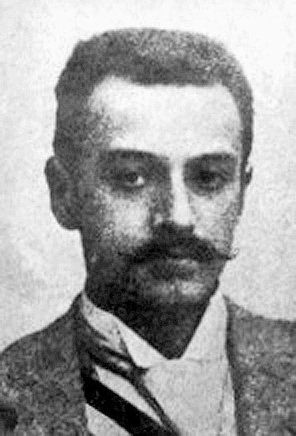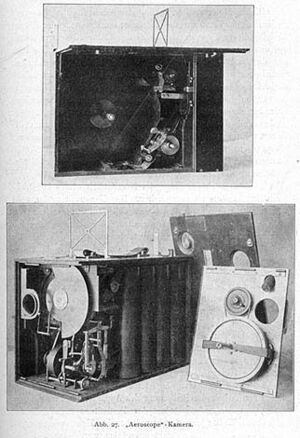Kazimierz Prószyński facts for kids
Quick facts for kids
Kazimierz Prószynski
|
|
|---|---|
 |
|
| Born | 4 April 1875 Warsaw, Poland
|
| Died | 13 March 1945 (aged 69) Mauthausen, Nazi Germany
|
| Nationality | Polish |
| Occupation | Inventor, film director |
| Known for | Invention of the Pleograph and the Aeroscope |
| Signature | |
 |
|

Kazimierz Prószyński (born April 4, 1875 – died March 13, 1945) was a Polish inventor. He made big contributions to the world of cinematography, which is all about making movies. He even patented his first film camera, called the Pleograph, before the famous Lumière brothers. He also improved movie projectors and invented the Aeroscope, a camera that changed how films were made.
Contents
The Life of an Inventor
Kazimierz Prószyński was born in Warsaw, Poland. He studied in both Poland and Belgium. He also worked in France, England, and the United States. His family had a history of creativity and challenges. His grandfather, Stanisław Antoni Prószyński, was a photographer who faced trouble for showing Polish patriotic symbols in his photos. Kazimierz's father, Konrad Prószyński, was a writer and educator.
Early Camera Inventions
In 1894, Kazimierz Prószyński built one of the very first movie cameras. He called it the Pleograph. This amazing machine could both take pictures and project them as moving images. He created this device even before the Lumière brothers got their patent for their own camera. Prószyński also made several films in Poland in the early 1900s. He also found a way to make film projectors better. He even figured out how to make sound and film tracks play together!
The Aeroscope Camera
Kazimierz Prószyński spent a lot of his life working outside of Poland. In the early 1900s, he was busy in France and England. There, he invented and produced the Aeroscope camera in 1909. This camera was special because it was powered by compressed air.
With the Aeroscope, a cameraman didn't have to turn a crank. This was a big deal because it meant they could use both hands to control the camera. This made it possible to film in tough situations, like from airplanes! Before filming, you would pump air into the camera system. It was like pumping up a bicycle tire.
Hundreds of these light and easy-to-carry Aeroscope cameras were used. British Army cameramen used them during World War I. Newsreel cameramen also used them until the late 1920s. Even as late as 1940, at the start of World War II, some British cameramen were still using them.
Return to Poland
After Poland became independent again in November 1918, Prószyński returned home. He came back with his English wife, Dorothy, and their children, Kazimierz junior and Irena. It was hard for him to find business partners for his inventions in Poland.
In 1922, he started a company called Oko, which means "eye" in Polish. He wanted to make a simple camera for everyday people and schools. But the economic problems of the 1920s stopped his plans. He kept working on other inventions, like home film projectors and reading machines for blind people. However, he couldn't mass-produce any of them.
Challenges and Legacy
During World War II, when Germany occupied Poland, German police found Prószyński's workshop. They arrested him and a co-worker. He was released after 10 days but remained under suspicion. He had to move often to avoid being arrested again. Sadly, on August 25, 1944, during the Warsaw Uprising, he was arrested once more.
Kazimierz Prószyński died in a Nazi concentration camp called Mauthausen in the spring of 1945. He was prisoner number 129957. This was shortly before the camp was freed.
Kazimierz Prószyński is remembered as one of the most important pioneers of Polish cinema and filmmaking. He is often mentioned alongside Bolesław Matuszewski and Jan Szczepanik.
See also
- List of Poles
- Timeline of Polish science and technology


